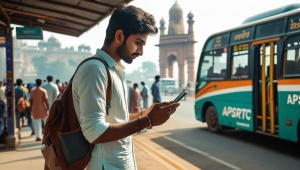
India moves on buses. Whether you are planning a work trip, visiting family, or heading out for a weekend break, you will compare private bus operators with state transport undertakings. This guide explains the differences so you can book with confidence and clarity while recognising the public value delivered by state services.
What Each Option Means
Private bus operators are companies or individual entrepreneurs who run services on permitted routes. State transport refers to government-run undertakings that operate scheduled buses across cities, towns, and rural belts. Think of state networks that link big hubs with small communities and keep daily mobility steady.
Why This Comparison Matters
Choosing a bus is not only about price. You consider timing, comfort, boarding points, and how predictable the trip feels. State undertakings focus on universal access and continuity. Private operators often specialise in particular corridors or traveller profiles. Put together, they create a complementary ecosystem that gives you options without leaving any region behind.
Booking and Ticketing
Booking with either option is straightforward today. You can:
● Use official websites and trusted apps.
● Visit authorised counters at bus stations.
● Check recognised third-party platforms that aggregate schedules.
Private operators may list multiple boarding points within a city, which is handy if you live far from the main terminus. State transport networks usually publish fixed timetables and transparent fares, making it easier to plan and budget for regular travel. Services from APSRTC, the Andhra Pradesh State Road Transport Corporation, are a familiar example of clear schedules and extensive coverage.
Routes and Coverage
State transport prioritises coverage. These networks connect district headquarters, smaller towns, pilgrimage centres, and educational hubs with regular, dependable services. This wide footprint supports students, workers, and families who depend on consistent timings. Private buses, meanwhile, may focus on high-demand corridors and express runs. Together, both sides widen the choice and keep the map connected.
Fleet and On-Board Experience
You will find a range of buses on either side, from ordinary services to premium categories. Private fleets may include sleeper and semi-sleeper formats that suit overnight journeys. State networks deploy categories for different budgets and distances, and many refresh their fleets to improve ride comfort. For long trips, look at seat design, legroom, ventilation or air-conditioning, and the location of charging points. A small travel pillow, a light shawl, and a bottle of water can make a big difference.
Safety and Compliance
Safety is a shared priority. State transport undertakings follow structured driver training, route permissions, and periodic vehicle fitness checks. Reputed private carriers invest in trained staff and disciplined operations. As a passenger, you can add a layer of caution by choosing recognised boarding points, checking the operator name on official portals, and wearing seat belts where provided. Keep helpline numbers and depot contacts handy on festival weekends.
Punctuality and Reliability
Reliability matters to commuters and long-distance travellers alike. State transport is built around published schedules and continuity, including at early or late hours on social-service routes. Private operators often align departures with demand patterns and neighbourhood boarding clusters, which can reduce travel time to the pick-up point. If you value a strict timetable, the state network’s clockwork approach is reassuring. If you want a convenient pick-up, browse private listings near your neighbourhood.
Fares and Value for Money
State transport is designed around accessible pricing and public value. That helps families, students, and daily commuters plan predictable budgets. Private operators may vary fares by season, day, bus type, and advance purchase window. This flexibility can be helpful if you want to trade timing or amenities for price. Many travellers mix and match: a state bus for routine trips where predictability matters, and a private service when a specific departure or format fits best.
Amenities, Baggage, and Special Services
Across both categories, you will find practical amenities:
● Clearly marked luggage areas or boot space.
● Water and charging points on selected services.
● Seat selection during booking for peace of mind.
● Assistance for seniors and families at major bus stands.
State networks also run special services around festivals or exams, aligning with public needs. Private operators may add comfort-led touches on overnight runs. Checking the inclusions before you pay helps you arrive prepared.
Accessibility and Inclusion
Buses remain one of the most inclusive modes of transport. State undertakings lead on coverage, concession categories set by policy, and depot-level support for passengers who need extra assistance. Private operators contribute by adding departures on busy corridors and tailoring formats for different comfort preferences. The combined network helps more people reach work, school, hospitals, and pilgrimage centres with dignity.
Sustainability
Choosing the bus supports quieter roads and better air quality compared to single-occupant vehicles. State transport plays a role in long-term fleet upgrades and route planning that optimises loads. Private carriers complement this by modernising vehicles over time and balancing demand on peak days. For travellers, a full bus is not only convenient – it is an easy step towards a lighter footprint.
How to Choose for Your Next Trip?
Use this quick filter the next time you book:
● Trip purpose: For routine commutes or civic trips, a scheduled state service is straightforward. For a once-off express run at a specific hour, a private departure may match your plan.
● Route type: If you are heading to a smaller town or a stop along a district route, the state network likely has a direct or connecting option.
● Comfort needs: Look at seat layout, legroom, and air-conditioning. Overnight travellers often pick sleeper or semi-sleeper formats where available.
● Budget and flexibility: If predictability matters, state fares keep planning simple. If timing is critical, browse private schedules for nearby boarding points.
Smart Booking Tips
● Book early for weekends, festivals, and exam seasons.
● Arrive a little ahead of time to board calmly and stow luggage.
● Carry a valid ID, soft copies of your ticket, and a compact day bag for valuables.
● Label your suitcase and keep essentials, such as medicines, a charger, and hand sanitiser, within reach.
● Use trusted platforms and read rescheduling or refund terms before you pay.
The Bottom Line
Private bus operators and state transport are partners in India’s mobility story. State undertakings keep the network inclusive, reliable, and far-reaching, while private carriers add choice in formats and timings on busy corridors. When you match your trip goals with the strengths of each, you get a smooth, value-led journey, and you support a system that helps millions travel every single day.







